The Asociación Multisectorial de la Información (ASEDIE) has published the eleventh edition of its Report on the Infomediary Sector, in which it reviews the health of companies that generate applications, products and/or services based on information from the public sector, taking into account that it is the holder of the most valuable data.
Many of the datasets that enable the infomediary sector to develop solutions are included in the lists of High Value Datasets (HVDS) recently published by the European Union. An initiative that recognises the potential of public information and adds to the aim of boosting the data economy in line with the European Parliament's proposed Data Law.
ASEDIE brings together companies from different sectors that promote the data economy, which are mainly nourished by the data provided by the public sector. Among its objectives is to promote the sector and contribute to raising society's awareness of its benefits and impact. It is estimated that the data economy will generate €270 billion of additional GDP for EU Member States by 2028.
The presentation of this edition of the report, entitled 'The Data Economy in the infomediary field', took place on 22 March in Red.es's Enredadera room. In this year's edition of the report, 710 active companies have been identified, with a turnover of more than 2,278 million euros. It should be noted that the first report in 2013 counted 444 companies. Therefore, the sector has grown by 60% in a decade.
Main conclusions of the report
- The infomediary sector has grown by 12.1%, a figure above the national GDP growth of 7.6%. These data are drawn from the analysis of the 472 companies (66% of the sample) that submitted their accounts for the previous years.
- The number of employees is 22,663. Workers are highly concentrated in a few companies: 62% of them have less than 10 workers. The subsector with the highest number of professionals is Geographic information, with 30% of the total. Together with the sub-sectors Financial economics, Technical consultancy and Market research, they account for 75% of the employees.
- Employment in the companies of the Infomediary Sector grew by 1.7%, compared to a fall of 1.1% in the previous year. All sub-sectors have grown, except for Tourism and Culture, which have remained the same, and Technical Consultancy and Market Research, which have decreased.
- The average turnover per employee exceeded 100,000 euros, an increase of 6.6% compared to the previous year. On the other hand, the average expenditure per employee was 45,000 euros.
- The aggregate turnover was 2,279,613,288 euros. The Geographical Information and Economic and Financial subsectors account for 46% of sales.
- The aggregate subscribed capital is 250,115,989 euros. The three most capitalised subsectors are Market Research, Economic and Financial and Geographic Information, which account for 66% of capitalisation.
- The net result exceeds 180 million euros, 70 million more than last year. The Economic and Financial subsector accounted for 66% of total profits.
- The sub-sectors of Geographical Information, Market Research, Financial Economics and Computer Infomediaries account for 76% of the infomediary companies, with a total of 540 companies out of the 710 active companies.
- The Community of Madrid is home to the largest number of companies in the sector, with 39%, followed by Catalonia (13%), Andalusia (11%) and the Community of Valencia (9%).
As the report shows, the arrival of new companies is driving the development of a sector that already has a turnover of around 2,300 million euros per year, and which is growing at a higher rate than other macroeconomic indicators in the country. These data show not only that the Infomediary Sector is in good health, but also its resilience and growth potential.
Progress of the Study on the impact of open data in Spain
The report also includes the results of a survey of the different actors that make up the data ecosystem, in collaboration with the Faculty of Information Sciences of the Complutense University of Madrid. This survey is presented as the first exercise of a more ambitious study that aims to know the impact of open data in Spain and to identify the main barriers to its access and availability. To this end, a questionnaire has been sent to members of the public, private and academic sectors. Among the main conclusions of this first survey, we can highlight the following:
- As main barriers to publishing information, 65% of respondents from the public sector mentioned lack of human resources, 39% lack of political leadership and 38% poor data quality.
- The biggest obstacle in accessing public data for re-use is for public sector respondents that the information provided in the data is not homogeneous (41.9%). Respondents from the academic sector point to the lack of quality of the data (43%) and from the private sector it is believed that the main barrier is the lack of updating (49%).
- In terms of the frequency of use of public data, 63% of respondents say that they use the data every day or at least once a week.
- 61% of respondents use the data published on the datos.gob.es portal.
- Respondents overwhelmingly believe that the impact of data openness on the private sector is positive. Thus, 77% of private sector respondents indicate that accessing public data is economically viable and 89% of them say that public data enables them to develop useful solutions.
- 95% of respondents call for a compendium of regulations affecting the access, publication and re-use of public sector data.
- 27% of public sector respondents say they are not aware of the six categories of high-value data set out in Commission Implementing Regulation (EU) 20137138 .
This shows that most respondents are aware of the potential of the sector and the impact of public sector data, although they indicate that some obstacles to re-use need to be overcome and believe that a compendium of the different existing regulations would facilitate their implementation and help the development of the sector.
Top 3 ASEDIE
As in previous editions, the report includes the status of the Top 3 ASEDIE, an initiative that aims for all Autonomous Communities to fully open three sets of data, following unified criteria that facilitate their reuse, and which is included in the IV Open Government Plan. In 2019, the opening of the Cooperatives, Associations and Foundations databases was proposed, and there are currently 16 Autonomous Communities in which they can be accessed in full. Moreover, in eight of them, it is possible to access the NIF with a unique identifier, which improves transparency and makes the information more accurate.
Taking into account the good results of the first proposal, in 2020 a new request for opening data was launched, the Second Top 3 ASEDIE, in this case of Energy Efficiency Certificates, SAT Registries (Agricultural Transformation Companies) and Industrial Estates, whose evolution has also been very positive. The following map shows the opening situation of these three new databases in 2023.
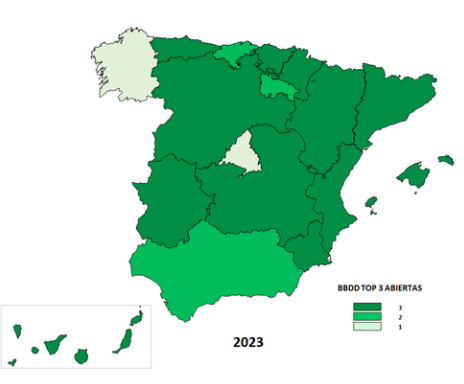
The Top 3 ASEDIE initiative has been a success and has become a reference in the sector, promoting the opening of databases in a joint manner and demonstrating that it is possible to harmonise public data sources to put them at the service of society.
The next steps in this sense will be to monitor the databases already open and to disseminate them at all levels, including the identification of good practices of the Administration and the selection of examples to encourage public-private collaboration in open data. In addition, a new top 3 will be identified to advance in the opening of new databases, and a new initiative will be launched to reach the bodies of the General State Administration, with the identification of a new Top 3 AGE.
Success stories
The report also includes a series of success stories of products and services developed with public sector data, such as Iberinform's API Market, which facilitates access to and integration of 52 sets of company and self-employed data in company management systems. Another successful case is Geocode, a solution focused on standardisation, validation, correction, codification and geolocation processes for postal addresses in Spain and Portugal.
Geomarketing makes it possible to increase the speed of calculating geospatial data and Infoempresa.com has improved its activity reports on Spanish companies, making them more visual, complete and intuitive. Finally, Pyramid Data makes it possible to access the Energy Efficiency Certificates (EEC) of a given property portfolio.
As examples of good practices in the public sector, the ASEDIE report highlights the open statistical data as a driver of the Data Economy of the Canary Islands Statistics Institute (ISTAC) and the technology for the opening of data of the Open Data Portal of the Andalusian Regional Government (Junta de Andalucía).
As a novelty, the category of examples of good practices in the academic sector has been incorporated, which recognises the work carried out by the Geospatial Code and the Report on the state of open data in Spain III, by the Rey Juan Carlos University and FIWARE Foundation.
The 11th ASEDIE Report on the Data Economy in the infomediary field can be downloaded from the ASEDIE website in Spanish. The presentations of the economic indicators and the Top 3 and the Data Ecosystem are also available.
In summary, the report shows the good health of the industry that confirms its recovery after the pandemic, its resilience and growth potential and, in addition, the good results of public-private collaboration and its impact on the data economy are observed.
Aragón Open Data, the open data portal of the Government of Aragón, will present its most recent work on 15 March 2023 to present its lines of action and progress in the field of open data and linked data.
What does 'Aragón Open Data: Open and connect data' consist of?
In this meeting, which is part of the events framed in the Open Data Days 2023, Aragón Open Data will take the opportunity to talk about the evolution of its open data platform and the improvement of the quality of the data offered.
In this line, the conference 'Aragón Open Data: Open and connect data' will also focus on detailing the functioning of Aragopedia, its new linked data strategy.
Through a series of technical explanations, supported by a demo, attendees will learn how this service works, based on the new structure of Interoperable Information of Aragon (EI2A) that allows sharing, connecting and relating certain data available on the Aragon Open Data portal.
In order to detail as precisely as possible, the approach of the conference, we share the programme below:
- Welcome to the conference. Julián Moyano, coordinator of Aragón Open Data.
- Introduction to Aragón Open Data (Marc Garriga, Desidedatum)
- Improving the quality of the data and its semantisation (Koldo Z. / Susana G.)
- Previous situation and current situation
- New navigation focused on Aragón Open Data and Aragopedia data (Pedro M. / Beni)
- Explanation and Demo
- My experience with Aragopedia (Sofía Arguís, Documentalist and user of Aragón Open Data )
- Process of identification, processing and opening of new data (Cristina C.)
- Starting point and challenges encountered to achieve openness.
- Conclusions (Marc Garriga)
- Question/Comment Time
Where and when is it being held?
The technical conference 'Aragón Open Data: Open and connect data' will be held on 15 March from 12:00 to 13:30 online. Therefore, in order to attend it, interested users must fill in the form available at the following point.
How can I register?
To attend and access the online session you can fill in the following form and if you have any questions, do not hesitate to write to us at opendata@aragon.es.
Aragón Open Data is co-financed by the European Union, European Regional Development Fund (ERDF) "Building Europe from Aragon.
This report published by the European Data Portal explores the so-called Citizen Generated Data (CGD). This category of data refers to those generated by citizens. There is a lack of this type of data within European open data portals, mainly due to the lack of publication and management of CGDs by public administrations.
The document analyzes various open data portals, whose main objective is to provide a vision of the CGDs that can be part of these portals and how to include them by public administrations. It should be noted that during the analysis, a framework is established for the description, reference, and characterization of the CGDs.
Finally, based on the conclusions of the previous analysis, the document offers a series of recommendations and guidelines for data publishers. The objective is to increase and improve the presence of CGDs in the publication of open data, involving citizens in the design of policy, processes and governance.
This report is available at the following link: "Data.europa.eu and citizen-generated data"
The pandemic situation we have experienced in recent years has led to a large number of events being held online. This was the case of the Iberian Conference on Spatial Data Infrastructures (JIIDE), whose 2020 and 2021 editions had a virtual format. However, the situation has changed and in 2022 we will be able to meet again to discuss the latest trends in geographic information.
Seville will host JIIDE 2022
Seville has been the city chosen to bring together all those professionals from the public administration, private sector and academia interested in geographic information and who use Spatial Data Infrastructures (SDI) in the exercise of their activities.
Specifically, the event will take place from 25 to 27 October at the University of Seville. You can find more information here.
Focus on user experience
This year's slogan is "Experience and technological evolution: bringing the SDI closer to citizens". The aim is to emphasise new technological trends and their use to provide citizens with solutions that solve specific problems, through the publication and processing of geographic information in a standardised, interoperable and open way.
Over three days, attendees will be able to share experiences and use cases on how to use Big Data, Artificial Intelligence and Cloud Computing techniques to improve the analysis capacity, storage and web publication of large volumes of data from various sources, including real-time sensors.
New specifications and standards that have emerged will also be discussed, as well as the ongoing evaluation of the INSPIRE Directive.
Agenda now available
Although some participations are still to be confirmed, the programme is already available on the conference website. There will be around 80 communications where experiences related to real projects will be presented, 7 technical workshops where specific knowledge will be shared and a round table to promote debate.
Among the presentations there are some focused on open data. This is the case of Valencia City Council, which will talk about how they use open data to obtain environmental equity in the city's neighbourhoods, or the session dedicated to the "Digital aerial photo library of Andalusia: a project for the convergence of SDIs and Open-Data".
How can I attend?
The event is free of charge, but to attend you need to register using this form. You must indicate the day you wish to attend.
For the moment, registration is open to attend in person, but in September, the website of the conference will offer the possibility of participating in the JIIDE virtually.
Organisers
The Jornadas Ibéricas de Infraestructuras de Datos Espaciales (JIIDE) were born from the collaboration of the Directorate General of Territory of Portugal, the National Geographic Institute of Spain and the Government of Andorra. On this occasion, the Institute of Statistics and Cartography of Andalusia and the University of Seville join as organisers.
A data space is an ecosystem where, on a voluntary basis, the data of its participants (public sector, large and small technology or business companies, individuals, research organizations, etc.) are pooled. Thus, under a context of sovereignty, trust and security, products or services can be shared, consumed and designed from these data spaces.
This is especially important because if the user feels that he has control over his own data, thanks to clear and concise communication about the terms and conditions that will mark its use, the sharing of such data will become effective, thus promoting the economic and social development of the environment.
In line with this idea and with the aim of improving the design of data spaces, the Data Office establishes a series of characteristics whose objective is to record the regulations that must be followed to design, from an architectural point of view, efficient and functional data spaces.
We summarize in the following visual some of the most important characteristics for the creation of data spaces. To consult the original document and all the standards proposed by the Data Office, please download the attached document at the end of this article.
(You can download the accessible version in word here)
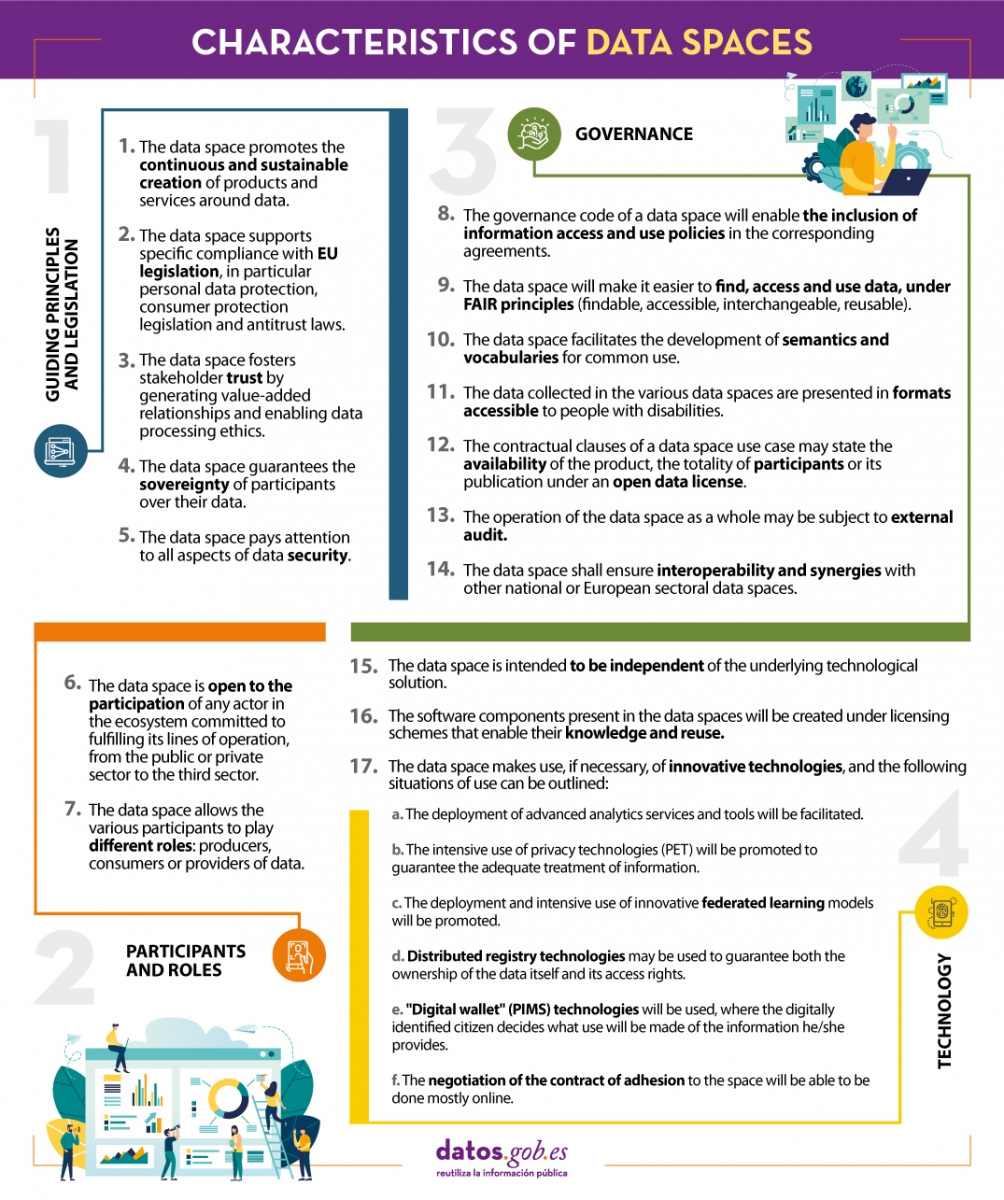
This report published by the European Data Portal (EDP) covers the following topics.
What are the needs of open data re-users of public sector institutions in Europe? This question is key to facilitate the publication of open data and support for re-users of EU institutions and Member States' public authorities based on their needs for policy-making, service delivery and organizational management.
This discussion paper provides an overview of the state of existing methods and indicators in the European open data landscape to assess the needs of public institutions as data re-users.
This overview serves as a basis for a discussion with public sector stakeholders on appropriate methods and indicators for measuring the demand for data from public institutions to encourage the publication of demand-driven data.
The report is available at this link: "Measuring Data Demand Within the Public Sector"
Data are fundamental to solving the social and economic challenges we face today. It allows us to understand the causes behind a given situation and the factors that influence it, to estimate how it is evolving and to make informed decisions for change.
The problem is that solving such challenges often requires a combination of data from different sources:
- Data provided by the public sector
- Data from multiple private sector companies
- Citizen-generated data
But how can such collaboration be achieved? This is the question posed in the report "How to facilitate data collaboration to solve societal problems", written by Jose Luis Marín in the framework of the Aporta Initiative.
The report begins with a brief introduction outlining the current state of data openness in the public and private sectors, as well as in the citizenry. Then, it discusses the main barriers to data sharing by companies and citizens, the individual and collective benefits that can motivate these practices in the public interest, and the policies that can be put in place by public administrations to compensate and encourage collaboration.
Once the context is clear, it is time to look at some of the existing mechanisms for collaboration in data collection, sharing or processing to address a societal challenge. Although there are no systematised analyses of ideal forms of governance, four formulas have been identified for this report:
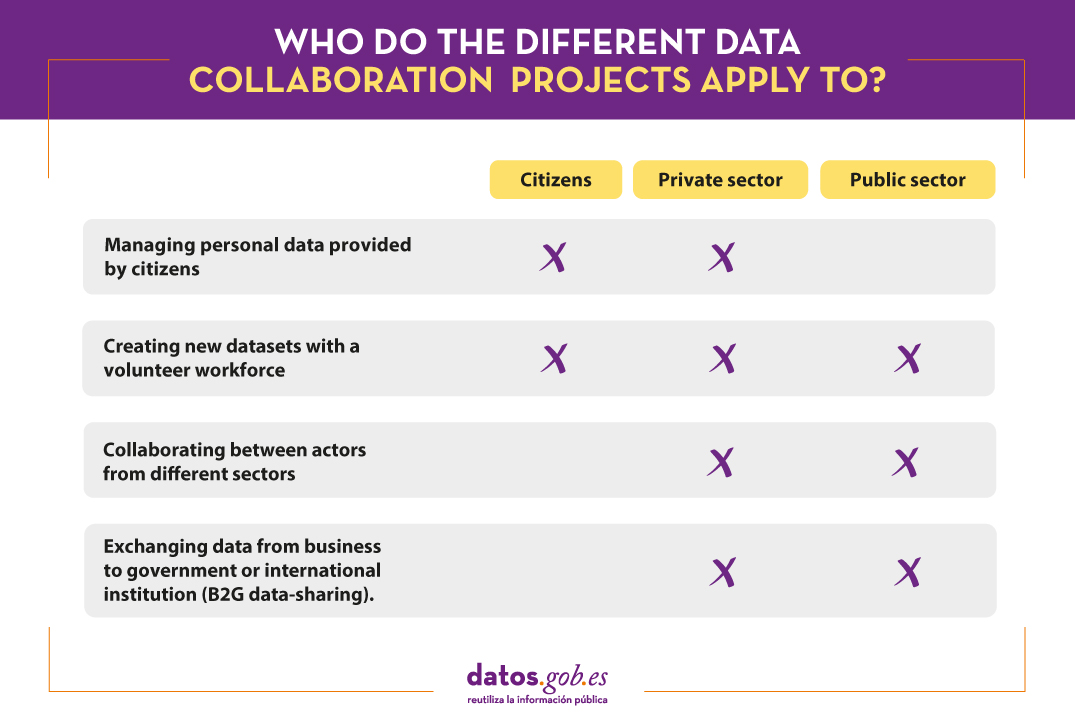
In order to illustrate and better understand each formula, the report includes multiple examples of international success stories, such as the Accelerating Medicines Partnership (AMP), which focuses on transforming the current model of developing new diagnostics and treatments, or the Open Apparel Registry (OAR), which aims to contribute to improving human rights and environmental conditions around factories.
The report concludes with a series of resources to help organisations collaborate successfully and reduce barriers, including collaboration networks, collaboration frameworks, courses and trainings.
Below, you can download the report, as well as access the complementary materials (executive summary, video-interview and summary presentation). The report is translated into English, but additional materials are available in Spanish version only.
Local statistical data helps us better understand our environment and identify variations between regions. This is essential to be able to formulate local policies tailored to the specific needs of the local population, something that has even been highlighted by the UN in one of its reports. In this sense, in the datos.gob.es catalog you can find statistical information on different localities and regions, such as the population and housing census, administrative records or even economic indicators.
One of the latest additions to our catalog is the Canary Islands Statistics Institute (Istac), as part of the datos.canarias.es initiative. The institute is the new Canary Islands Open Data Portal that is positioned as the only point of access to open data on the island in collaboration with the rest of the regional public administrations.
At the end of January, datos.canarias.es federated with datos.gob.es, incorporating 7,460 new datasets from the Istac and other organizations on the Island.
What kinds of data sets are available?
The federated data are categorized according to the recommendations of the Application Guide of the Technical Standard for Interoperability for the Reuse of Information Resources and address a wide range of topics related to the territory, the environment, demographics, the economy, and living conditions or the public sector. Shared data is divided into the following categories:
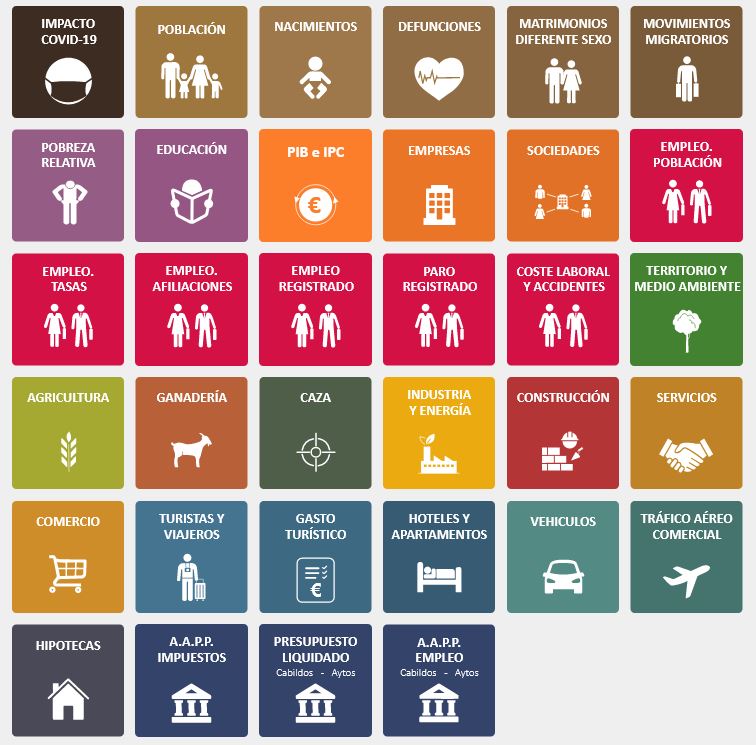
Istac's commitment to open data
The Decree approving the Statistical Plan of the Canary Islands 2018-2022 (PEC-22), establishes that during its execution the reuse of statistical data will be promoted in accordance with the Law on reuse of public sector information. At the same time, it indicates that the Statistical Data and Metadata Infrastructure (eDatos) will be the support for the open and interoperable dissemination of the data published by the statistical activities of the PEC-22, becoming the only channel for the decentralized dissemination of statistics in the corporate websites of the Government of the Canary Islands.
To comply with the aforementioned guidelines, the Istac has made the open data portal of public statistics in the Canary Islands available to the public, which, under the principles of public statistics and data reuse, distributes the data generated in a manner free, in open formats and with licenses that allow its reuse for commercial and non-commercial purposes.
The portal integrates data and metadata based on standardized semantic assets, geographic information and services to promote their use; and it has programmable application interfaces (API) that facilitate the access and download of the information by third parties. In addition to these APIs, it also provides a series of query tools that allow both downloading the data (for example an Extension for QGIS or an R Package), and taking it to another web or application, such as Widgets, Tableau Public or Google Public Data Explorer.
The website also has a statistical indicator viewer. The user can select the information they want to view from a large number of categories, for example, births and deaths, or the workforce. You can also choose the geographic space (the community as a whole or any specific island or municipality), the type of data (annual, interperiodic variation, etc.) and the temporal range. With this information, the tool will generate the graph with the Istac data.
All these tools show the interest of the Istac and the Government of the Canary Islands not only to facilitate access to their data, but also to promote its reuse by developers who want to create value-added products. With its integration in datos.canarias.es, the visibility of the local statistical data of the Canary Islands is promoted, at the same time that access to the data of interest of the entire Autonomous Community is homogenized.
Infomediary activity is not classified as such in the CNAE. Therefore, the census of companies must be updated through indirect and ad hoc actions. Periodically, the National Observatory of Telecommunications and the Information Society (ONTSI) analyzes the state of this sector and collects the results in a report, which this year reaches its fifth edition.
Under the title "From Infomediary Sector to Economy Data. Characterization of the Infomediate Sector", this year's report starts from a new approach, more aligned with the European Union's vision. The document highlights that the infomediate sector is evolving towards the data economy, and takes as a reference the words of the European Commission, which defines "data companies" as "organizations whose main activity is to produce products, services and technologies related to data".
A sustainable sector in continuous growth
This year's report shows us that we are facing a sector that does not stop growing in a sustainable way. 708 companies have been identified, 32% more than in 2016. It is worth noting that the businesses that are created around this activity last over time, since 63.7% of the companies analyzed are more than 10 years old. The sector is mainly concentrated in Madrid, where more than 50% of the companies are located. It is followed by Catalonia, with 18.4%.
In recent years there has been an evolution towards businesses centred on digital technologies: the most recent companies are mainly in the field of programming and IT consultancy and information services.
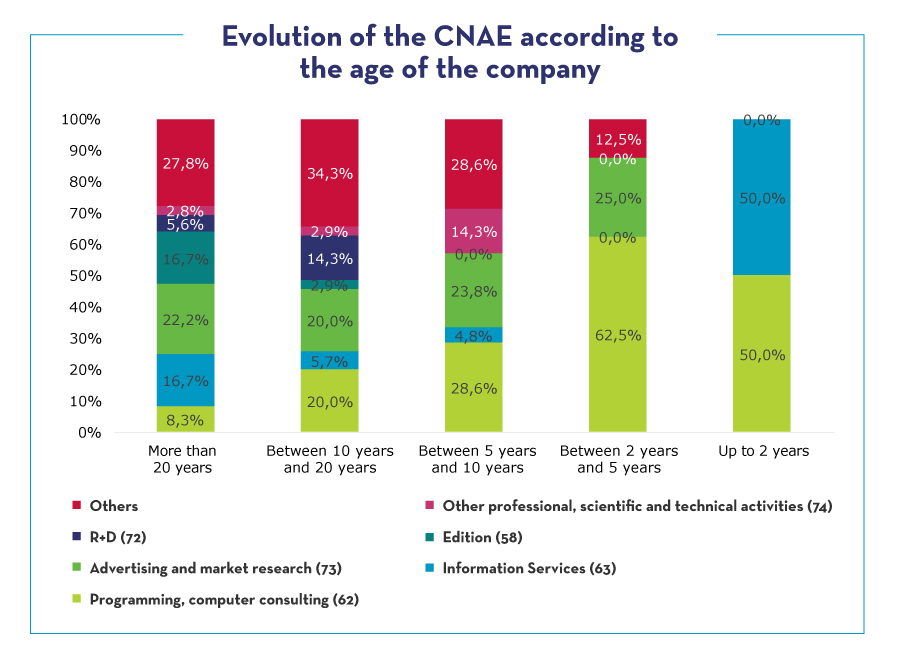
73.5% of the companies carry out more than one infomediaries activity, although the one that attracts more business in data analysis and/or visualization.

Almost 50% of these companies are micro-enterprises (with less than 10 employees) and only 6% have more than 250 employees. The turnover of the sector, however, is not negligible, estimated to reach 1,987 million euros in 2018, 15.4% more than in 2015. Of this volume, 718 million come from the reuse of information.
With regard to employment, in recent years there has been significant growth. The sector employs between 14,000 and 16,000 people, 14.3% more than in 2016. If we focus only on employees linked to data reuse, the growth is even more spectacular, 61.5%, reaching 7,700-8,400 workers.
Traditionally, the distribution of employment by gender in the infomediate sector has been equal (49.9% women and 50.1% men). However, the progressive introduction of digital technologies is breaking this parity in favor of men. Newer (and more technological) companies have many more men than women on their staff.
1 in 5 companies uses data from public sources
More than 80% of the companies analyzed use data from public sources to develop these services, which are combined with private data in 69.9% of the cases. The most demanded public information belongs to the fields of trade, environment, economy and demography. They mainly access this data in non-proprietary structured formats (csv, xml), although it is worth noting that there are still many suppliers that provide their data without structure (pdf, jpg), making it difficult to process automatically.
When asked about the data they most miss, the companies surveyed indicated that they would like to have more data on weather, real-time transport, tourism, demographics (with information disaggregated at the level of census sections), justice at the regional and local level, the public sector, the economy and the treasury.
These are just some of the report's conclusions, but there are many more. You can download the full report and its presentation below.
From its origins, the open data movement has been focused on opening up public sector data, and even the original statement of open data principles itself refers only to data from public administrations (open government data - OGD). However, this perception has evolved and today it is more common to speak of open data in a more general scope that includes all sectors, as demonstrated for example by the declaration of open data principles promoted more recently by the Open Data Charter, the wording of which is perfectly applicable to any sector.
On the other hand, while we now have a more than respectable and valuable amount of data available in open format from government, there are also some limitations with regard to governance and sustainability models for public data which, together with the remaining challenges of digital transformation in the sector, are to some extent limiting the ultimate availability of data. Data lifecycle management, technical and legal issues, adapting the skills of public employees or growing concerns about potential privacy issues are some of the barriers that public administrations have to face when trying to take their open data projects to the next level.
In this context, other data-producing sectors are also emerging as complementary sources to the hundreds of open data catalogues that governments have been publishing in recent years. These new data come from other publishers outside the public sector - such as the private sector, academia or the so-called third sector - all of them driven by different motivations and by the potential benefits associated with social reputation, innovation or attracting talent, among others. Even citizens themselves have now become a broad source of data, albeit sometimes unwittingly.
Thanks to this greater variety of data producers, the possibilities of enriching information by combining the different sources now available are increasing, but, at the same time, there is also a new need to improve coordination and integration between all parties in order to enable more efficient production and reuse of data and thus obtain the expected improvements in the social, economic and scientific spheres. The current challenge is therefore to find new models and collaborative relationships between the different parties that provide an adequate response to the existing challenges in achieving better management and availability of data, ultimately benefiting all parties and facilitating its reuse to a greater extent.
In order to get a more complete picture of the situation and to understand in more detail who these new data-producing sectors are, what their motivations are and what new models of collaboration are emerging between them, this report is divided into two parts:
![]()
In the first part of the report we will take a look at the different data producing sectors - leaving the public sector aside for a moment - and the alternative data sources they offer us, showing their motivations, their particularities and several examples.
![]()
In the second part of the report we will focus on analysing what models of collaboration can emerge between the public sector and other sectors to create joint actions to improve the governance, availability and ultimate re-use of data, showing again the differences and similarities between each of them and different examples of how they have been put into practice so far.
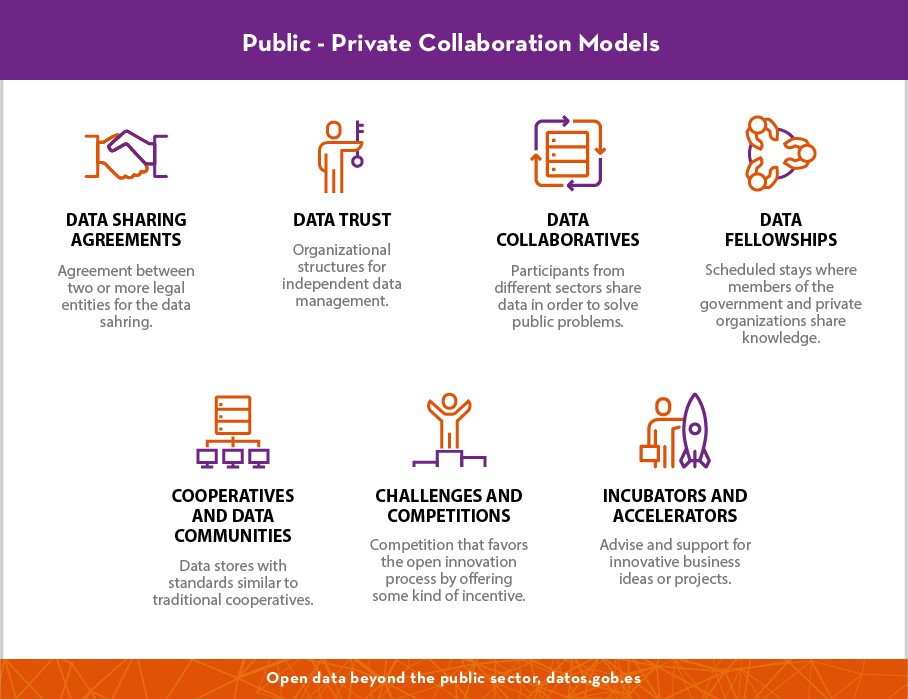
From the experimental vision of contests and competitions, to the purely entrepreneurial objective linked to the launch of incubators. From the models related to the legal responsibility point of view of data trusts, to the participative models of data collaboratives. From the actions with a more formative perspective of data fellowships, to the proposals aimed at empowering data cooperatives. All of them are possible models, some of them in a preliminary phase of consolidation but others more tested and refined, that can be more easily adopted. Let's discover them in this report and see how they can be put into practice in different contexts.